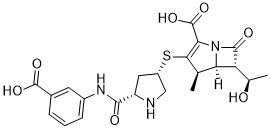This product is for research use only, not for human use. We do not sell to patients.

| Size | Price | Stock |
|---|---|---|
| 250mg | $960 | To Be Confirmed |
| 500mg | $1350 | To Be Confirmed |
| 1g | $2025 | To Be Confirmed |
Cat #: V3713 CAS #: 153832-46-3 Purity ≥ 98%
Description: Ertapenem (L-749345; Invanoz; MK-0826; Invanz) is a 1-β-methyl carbapenem antibiotic marketed by Merck as Invanz. Ertapenem is a long-acting, broad-spectrum antibiotic of β-lactam subclass. Ertapenem has a broad spectrum of antibacterial activity including common aerobic and anaerobic bacteria and organisms with extended-spectrum β-lactamases. Ertapenem is an inhibitor of bacteria cell-wall synthesis, it acts by binding to penicillin binding proteins located on the bacterial cell wall, in particular PBPs 2 and 3, thereby inhibiting the final transpeptidation step in the synthesis of peptidoglycan, an essential component of the bacterial cell wall. Inhibition of peptidoglycan synthesis results in weakening and lysis of the cell wall and cell death. Erapenem is resistant to hydrolysis by a variety of beta-lactamases, including penicillinases, cephalosporinases and extended-spectrum beta-lactamases.
References:
Publications Citing InvivoChem Products
Product Promise

- Physicochemical and Storage Information
- Protocol
- Related Biological Data
- Stock Solution Preparation
- Quality Control Documentation
| Molecular Weight (MW) | 475.5 |
|---|---|
| Molecular Formula | C22H25N3O7S |
| CAS No. | 153832-46-3 |
| Storage | -20℃ for 3 years in powder formr |
| -80℃ for 2 years in solvent | |
| Solubility In Vitro | DMSO: 100 mg/mL (201 mM) (sodium salt)r |
| Water: 100 mg/mL (201 mM) (sodium salt)r | |
| Ethanol: <1mg/mL (sodium salt) | |
| SMILES Code | O=C(C(N12)=C(S[C@@H]3CN[C@H](C(NC4=CC=CC(C(O)=O)=C4)=O)C3)[C@H](C)[C@]2([H])[C@@H]([C@H](O)C)C1=O)O |
| Synonyms | MK 826; L-749345; MK-826; L749345; MK826; L 749345; MK-0826; MK 0826; MK0826; Ertapenem Sodium; Trade Name: Invanoz; Invanz |
| Protocol | In Vitro | Ertapenem (0-100 μg/mL approximately, 48 h) is active against 99.1% of all anaerobes with a mode MIC of 0.12 μg/mL and MIC90 of 1 μg/mL, and MIC’s ≥8 μg/mL for B.fragilis and B.vulgatus species, respectively. |
|---|---|---|
| In Vivo | Ertapenem (Subcutaneous injection, 0-10 mg/kg, 0-120 h after infection, S. aureus thigh tissue infection model) shows > 3 log10 CFU reduction of organism at 10 mg/kg, and maintains the activity with 3.3 and 4.4 log10 CFU eliminated at 2 mg/kg. | |
| Animal model | S. aureus thigh tissue infection model (DBA/2 mice) | |
| Dosages | 0.5,1, 2, 5, 10 mg/kg (given at 2, 6, 10, 24, 48, 72, 96, 120 h) | |
| Administration | Subcutaneous injection (0.5 mL after infection) |
| Solvent volume to be added | Mass (the weight of a compound) | |||
|---|---|---|---|---|
| Mother liquor concentration | 1mg | 5mg | 10mg | 20mg |
| 1mM | 2.1030 mL | 10.5152 mL | 21.0305 mL | 42.0610 mL |
| 5mM | 0.4206 mL | 2.1030 mL | 4.2061 mL | 8.4122 mL |
| 10mM | 0.2103 mL | 1.0515 mL | 2.1030 mL | 4.2061 mL |
| 20mM | 0.1052 mL | 0.5258 mL | 1.0515 mL | 2.1030 mL |
| Quality Control Documentation |
|
|---|
This equation is commonly abbreviated as: C1 V1 = C2 V2
- (1) Please be sure that the solution is clear before the addition of next solvent. Dissolution methods like vortex, ultrasound or warming and heat may be used to aid dissolving.
- (2) Be sure to add the solvent(s) in order.




































